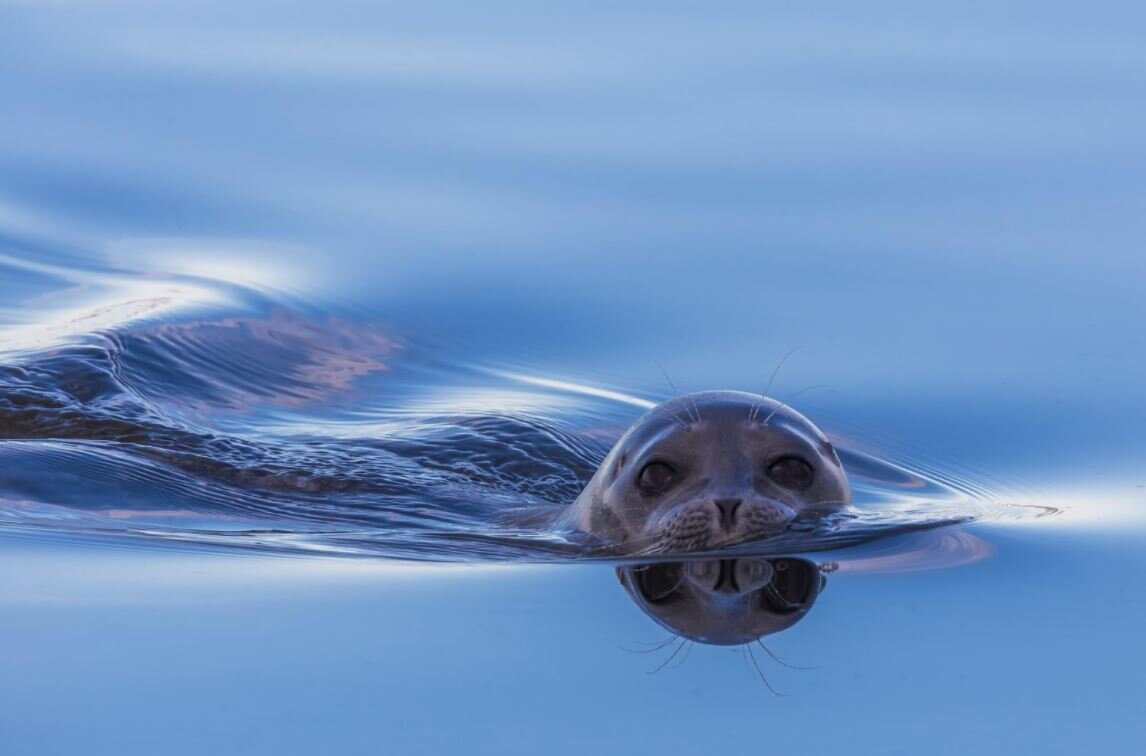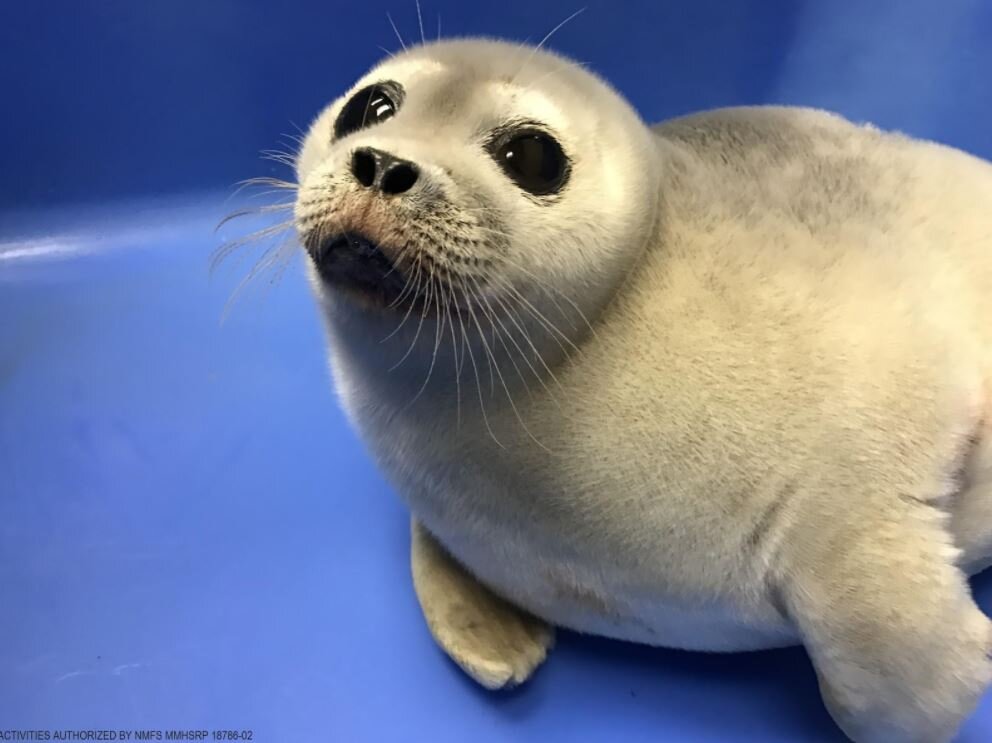Ringed Seal Fact Sheet
By Nick Kerle
Ringed seals are 1 of 4 ice seal species found in the Alaska Arctic. They are the smallest and most common of the 4, and can be found throughout the Beaufort and Chukchi Seas.
There are five subspecies of ringed seals living in seas and frozen lakes in Russia, Finland, and even Japan. Ringed seals diets are therefore highly adaptable to their environments, though they seem to seek out cod-like species of fish wherever they are.
Despite being so adaptable, ringed seals are at high risk of environmental changes. They are protected under the Marine Mammal Protection Act of 1972 and are also currently listed as endangered or threatened under the Endangered Species Act. These threats include:
Melting sea ice
Reduced snowfall
Health issues related general ecosystem changes
DID YOU KNOW…
Ringed seals can stay underwater for up to 45 minutes reaching depths of around 300 feet
Young ringed seals double their weight within two months of birth
They have strong claws that they use to maintain breathing holes through dense layers of ice up to 6 ft (2 m) thick
You may remember Yuki, the Japanese seal from Osaka that led to a plushie and went viral in early 2020. She’s a ringed seal! And probably the most famous ringed seal ever
Conservationists are currently proposing to designate a critical habitat for ringed and bearded seals in the U.S. Arctic
SCIENTIFIC AND COMMON NAMES
Phoca hispida – Ringed Seal; Known as NatchiQ in Inupiat; Niknik in Yu’pik; Nayir in Cup’ig
GENERAL DESCRIPTION
The ringed seal is the most abundant of the Alaska seals, which includes Bearded, Ringed, Spotted, and Ribbon Seals. They get their name from the small, light-colored rings on their back. There are currently five recognized subspecies of the ringed seal: Arctic ringed seals in the Arctic Basin and adjacent seas, including the Bering and Labrador Seas; Okhotsk ringed seals in the Sea of Okhotsk; Baltic ringed seals in the Baltic Sea; Ladoga ringed seals in Lake Ladoga, Russia; and Saimaa ringed seals in Lake Saimaa, Finland.
Ringed seals have a small head with a short snout, a pudgy body, and two small front flippers with strong claws. Their colors vary, but the basic pattern is a gray back with dark spots and a light belly. At birth, pups have a white, wooly natal coat (lanugo) that insulates them between four to six weeks so they can build fat reserves.
Ringed seals are the smallest of all pinnipeds (seals, sea lions, and walruses), ranging anywhere from 3.6 to 5.7 feet (1.1 to 1.7 meters) and weigh between 70 and 270 pounds (30 and 120 kilograms). At birth, the average weight of a ringed seal pup is about 10 pounds.
Adult ringed seals weigh the most in the winter and early spring when they have a thick layer of blubber under their skin. The blubber provides insulation and serves as an energy source during the breeding and pupping season. During the reproductive and molting seasons, the weight declines with the decrease in feeding.
Ringed seals live under solid sea ice by keeping breathing holes open with their claws. Female ringed seals make snow caves (lairs) above some breathing holes to give birth and raise pups and Males make lairs for resting. ringed seals usually live alone, but they can be found in large groups during the molting season, gathered around cracks or breathing holes in the ice.
Ringed seals make several types of vocalizations underwater which can’t be heard above water. Researchers understand very little about ringed seal behaviors like these, because both males and females spend the greater part of the year in lairs or in the water.
A Saima ringed seal, close cousin to Alaska ringed seals, hanging out on frozen ice in Lake Saima, Finland. Notice the ‘ringed’ pattern on its back!
RANGE
Ringed seals live in arctic waters and are usually found in ice floes and pack ice. They are circumpolar, ranging throughout the Arctic Basin and southward into adjacent seas, including the Bering and Labrador Seas. They can also be found in the Sea of Okhotsk and Sea of Japan in the western North Pacific and the Baltic Sea in the North Atlantic. Smaller landlocked populations live in Lakes Ladoga, Russia and Saimaa, Finland.
During winter and spring in the United States, ringed seals are found throughout the Beaufort and Chukchi Seas; they are found in the Bering Sea as far south as Bristol Bay during years of extensive ice coverage.
Researchers believe that seals generally move south as sea ice advances in the winter and north as sea ice retreats in the spring. However, some ringed seals are seen during ice-free periods in the Bering, Chukchi, and Beaufort Seas. They often move long distances this time of year, but their movements are not well understood. Adult seals appear to return to the same breeding territories each year, but it is unknown if young seals return to their birth region when they are old enough to breed.
Check out how biologists track Alaska Ice Seals living in an environment being changed by a rising climate...
THREATS/CONCERNS
In December 2012, the National Oceanic and Atmospheric Administration announced that ringed seals would be listed as a threatened species under the Endangered Species Act due to melting sea ice and reduced snowfall. The warming climate has led to less sea ice thickness, coverage, formation timing, and duration of coverage which may drastically affect ringed seal resting, molting, and pupping. Ringed seals rarely come ashore, and they depend almost exclusively on sea ice for their reproduction and livelihood.
Reduced snowfall poses another challenge for ringed seal pups, because they spend the first few weeks of life in snow dens for protection from predators and freezing. More pups are being pushed out of their shelters before they are able to survive in the open. Ringed seals also only have one pup per year, making them especially vulnerable to these environmental changes.
Additionally, ringed seals could be affected by offshore oil and gas exploration and development. An accidental or illegal discharge of oil or other toxic substances would have immediate and potentially long-term effects. ringed seals could also be directly affected by noise and physical disturbance of habitat associated with such activities.
As summer sea ice melts, there is a growing interest in using the Arctic Ocean as a possible waterway for coastal, regional, and trans-Arctic marine operations. This could pose a number of threats to Arctic ringed seals depending on the type and intensity of the shipping activity and its degree of spatial and temporal overlap with the seals.
Ringed seals are preyed upon by polar bears, walruses, and killer whales. A polar bear may kill a ringed seal every 2 to 6 days. Pups are eaten by polar bears, arctic foxes, red foxes, and ravens. Arctic foxes and polar bears use their acute sense of smell to locate lairs. During pupping, foxes will tunnel into these lairs to catch the pups. Polar bears will run and jump on the snow over the hole to collapse the lair and block the exit so it can catch the mother and the pup.
Ringed seals are also hunted by Alaska coastal residents from Mekoryuk to Kaktovik for human and dog food and the skins are used for clothing, equipment, and crafts.
LIFE HISTORY
Photo courtesy of the Alaska Sealife Center
After an 11 month gestation period, female ringed seals give birth to a single pup between April and May. They nurse pups for about two months and during that time the 10 pound pup doubles in weight. Most females will breed again within just a month of giving birth.
Pups learn how to dive shortly after birth. They are nursed for as long as 2 months in stable ice that is fastened to the coastline and as little as 3 to 6 weeks in moving ice. Pups are normally weaned before the break-up of spring ice.
Sexual maturity in ringed seals varies with population status. Most female ringed seals first ovulate at 5–6 years of age and first give birth at 6–8 years. Males become sexually mature at the same age. Mating takes place while mature females are still nursing their pups on the ice and is thought to occur under the ice near birth lairs.
During rut in April and May, males exhibit territorial behavior and emit a strong scent from glands of their faces; due to their scent, hunters refer to them as “kerosene” or “gasoline seals” and avoid harvesting them because they do not taste good. Polar bears also avoid male ringed seals this time of year.
Check out this video of a cute Saima ringed seal pup eating snow...
DIET
The ringed seal’s diet depends on availability, water depth, and distance from shore. They usually eat whatever small prey is available, including a variety of invertebrates, fish, and amphipods. In Alaska waters, the important food species are arctic cod, saffron cod, shrimps, and other crustaceans.
Ringed seas rarely prey on more than 10 to 15 species in any specific geographic location, and only two to four of these species are usually considered important prey. From late autumn through spring, cod tends to dominate the ringed seal diet, despite the variety in geographic location. During the open-water season, young seals often rely on crustaceans for the majority of their diet.
During their spring molt, ringed seals reduce their food intake.
Meet Dutch! She’s a ringed seal at the Alaska Sealife Center in Seward, Alaska…
RINGED SEAL COLORING SHEET
Tell us what you think about ringed seals! You can send us your comments on Facebook or Twitter. To support Alaska Wildlife Alliance and Alaska’s wildlife, become a member today for as little as $35 per year. If you haven’t already, subscribe to our free newsletter to learn more about what we do!
Information obtained from: NOAA Fisheries, National Geographic, The Alaska Sealife Center, Ice Seal Committee and Alaska Department of Fish and Game





